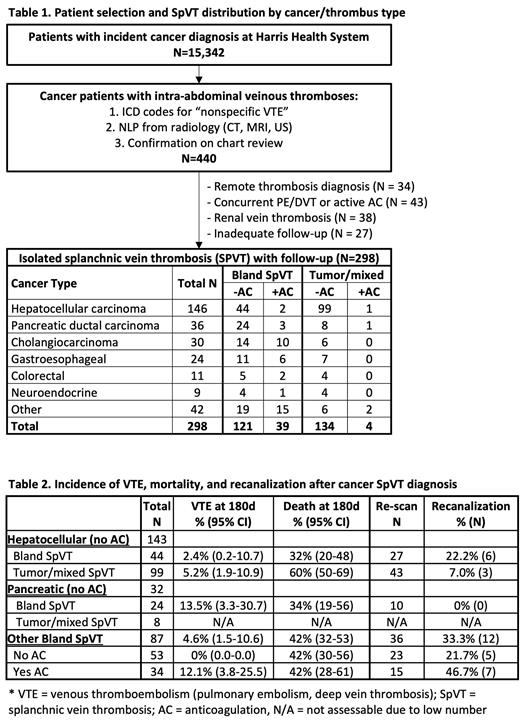Introduction : Venous thromboembolism (VTE), especially pulmonary embolism (PE) and deep vein thrombosis (DVT), is associated with increased morbidity in cancer patients. However, the clinical course and optimal management of unusual and isolated splanchnic vein thrombosis (iSpVT) remain unclear. Past studies often excluded cancer patients or combined them in heterogeneous cohorts. We aimed to describe the natural history of cancer associated iSpVT.
Methods : We queried a cancer registry linked database from a large safety-net hospital system from 2011-2020. Patients with incident cancer diagnosis and intra-abdominal venous thrombosis were identified by a combination of International Classification of Diseases (ICD) code and natural language processing (NLP) algorithm (Figure 1). iSpVT was defined as symptomatic or incidental portal, hepatic, splenic, mesenteric vein thrombosis without concurrent PE/DVT. Patients were excluded for remote SpVT >6 months (mo) before or >36 mo after cancer diagnosis, concurrent PE/DVT, existing anticoagulation (AC), or inadequate follow-up <3 mo (unless death).
Thrombus type was classified as bland vs. tumor/mixed based on radiology impression. AC was defined by intention for extended therapeutic AC. Venous recanalization was defined as resolution or reduction in thrombus size in a subset of patients with repeat contrast radiology scans in 3-12 mo. VTE was defined as PE or DVT. Bleeding was defined as ISTH major (MB) or clinically relevant non-major (CRNMB). Cumulative incidence of VTE at 180 days (d) was estimated using competing risk method and overall mortality was assessed by Kaplan Meier estimator.
Results : Figure 1 highlights the cohort selection where 298 of 15,342 patients (1.9%) met inclusion criteria for iSpVT. Median time from cancer diagnosis to iSpVT was 19d (IQR 0-138). Most occurred in upper gastrointestinal cancers; 54% were bland and 46% were tumor/mixed. Tumor (n=99) and bland (n-44) thrombi in hepatocellular carcinoma (HCC), along with bland thrombi in pancreatic ductal adenocarcinoma (PDCA) (n=24) comprised over half of iSpVT. AC rate differed by cancer and thrombus type. Most tumor thrombi regardless of cancer type did not receive AC (97%). Most HCC and PDCA regardless of thrombus type did not receive AC (96%). Among those with bland thrombi in other cancers, 39% received AC.
Due to strong selection bias for AC, we analyzed future VTE, bleeding, recanalization, and mortality in different subgroups: 1) untreated iSpVT in HCC/PDCA (compare to similar patients without SpVT); 2) all other cancers with bland iSpVT (compare AC vs. no AC) (Table 2). Among 143 HCC patients with untreated iSpVT, 44 had bland thrombi. The 180d VTE incidence was 2.4% (95% CI 0.2-10.7), which was non-significantly lower than HCC patients without iSpVT at 4.7% (95% CI 3.2-6.7). In contrast, 99 HCC patients with tumor thrombi had twice the risk of VTE and mortality compared to bland thrombi. Among 32 PDCA patients with untreated iSpVT, 24 had bland splenic vein thrombi due to tumor encasement. The 180d VTE incidence was 13.5% (3.3-30.7), similar to PDCA patients without SpVT at 17.2% (13.2-21.7).
Among 87 mixed cancer type patients with bland iSpVT, the overall 180d VTE incidence was 4.6% (1.5-10.6). Thirty-four received AC with a median duration of 81d (IQR 31-181). AC was associated with increased recanalization rate (46.7% vs. 21.7%); however, it was not associated with decreased VTE (12.1% vs. 0%) or mortality (42% vs. 42%) due to confounding by treatment indication. Notably, 3 of 4 VTE occurred < 2 weeks after stopping AC. Bleeding occurred in 26% (n=9) of patients on AC with 15% MB (n=5) and 12% CRNMB (n=4), at a median of 28d (IQR 7.5-115) after starting AC.
Conclusion: iSpVT in cancer patients is not a singular entity but rather a heterogeneous disease based on cancer and thrombus type. Tumor thrombi are associated with higher risk of future VTE and mortality. Untreated iSpVT in HCC and PDCA appear to have similar risk of VTE as those without SpVT, which supports current practice of not anticoagulating these patients. Beyond these cancers, AC varies by perceived risk of thrombosis vs bleeding. Despite strong selection bias, AC is associated with higher recanalization rate but at a cost of high bleeding risk. Prospective studies in a cancer-specific context are needed to determine if iSpVT should be treated similarly as PE/DVT among cancer patients.
Disclosures
Sukumar:Sanofi Genzyme: Honoraria.


This feature is available to Subscribers Only
Sign In or Create an Account Close Modal